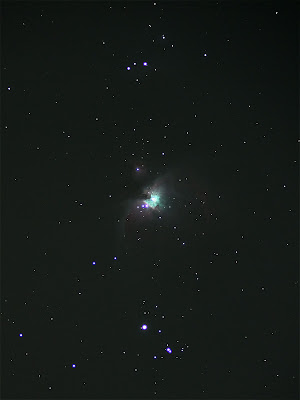We went to Dallas and I had the pleasure of visiting my first telescope shop - The Observatory. I had the opportunity to talk to the manager and get some tips on my next scope. He advised me that I could go up to a C8 with my mount (CG5) and still do photography.
So... my next stop was to check retail ($1200 - ouch) and start trolling the classifieds (
CloudyNights.com) and dreaming of a new scope. I didn't want another huge one so the C8 seemed like the natural choice. I found one and ordered it (at a very good price) and tonight I had the first chance to use it.
To explain to the layperson new equipment is the bane of astronomers everywhere. It almost always is succeeded by weeks of bad weather, etc. For some reason I was able to get it out and try it the second night of having it (unheard of). That being said let me explain the situation... poor seeing, full moon and new equipment. I wasn't going to be taking great shots anyway, so I might as well start the learning process of a new piece of equipment so I don't waste a really good night learning my way around it.
I spent about 4 hours working on it getting my feet wet and trying to get a little success (Ring Nebula).
- Finder - the scope didn't come with a finder, but I had an extra red dot in the shed so that wasn't a big deal - still had to align it and the battery isn't awesome so probably need a new battery and possibly later on a nicer finder. Still... the price is right and it gets the job done. With my 70 I've not even been using a finder.
- Collimation - Fun fun - I forgot that part of owning a reflector (of any sort) is collimating it. After spending some time working on it and using my Hotech laser collimator I went to the Interwebs and watched a tutorial on how to laser collimate an SCT. The irony is to do it you have to have done a star collimation first anyway and marked the spot the laser points to. So in effect the laser doesn't get you aligned, just gets you back to whatever you originally were. Still... after trying two different times I achieved a level of collimation I'm not miserable about. I'm sure I'll get better at it, but for now I'm not worried that I bought a lemon.
- Mount Alignment - Polar alignment of the mount is crucial and after some mucking about and recalibrating I finally reached a decent alignment for taking some shots. It didn't help that the moon was whitewashing the entire sky, but like I previously mentioned this was supposed to be a dry run anyway.




















